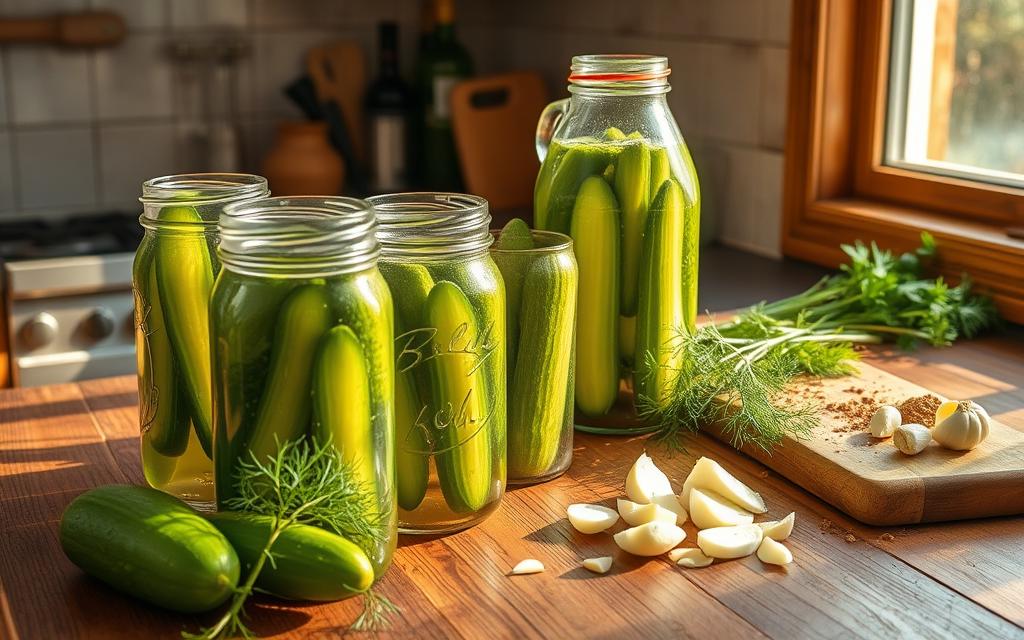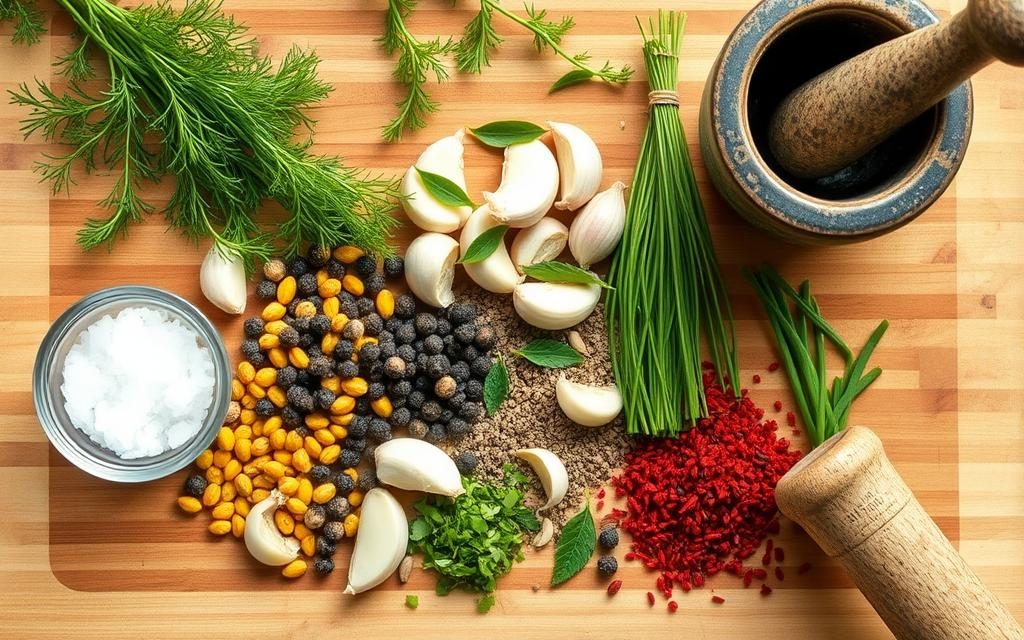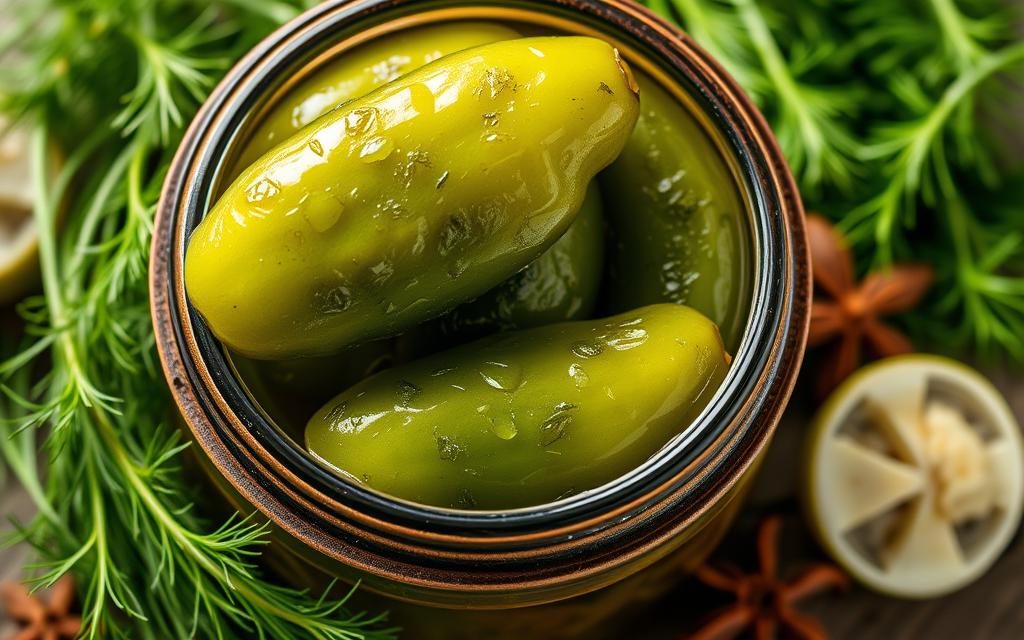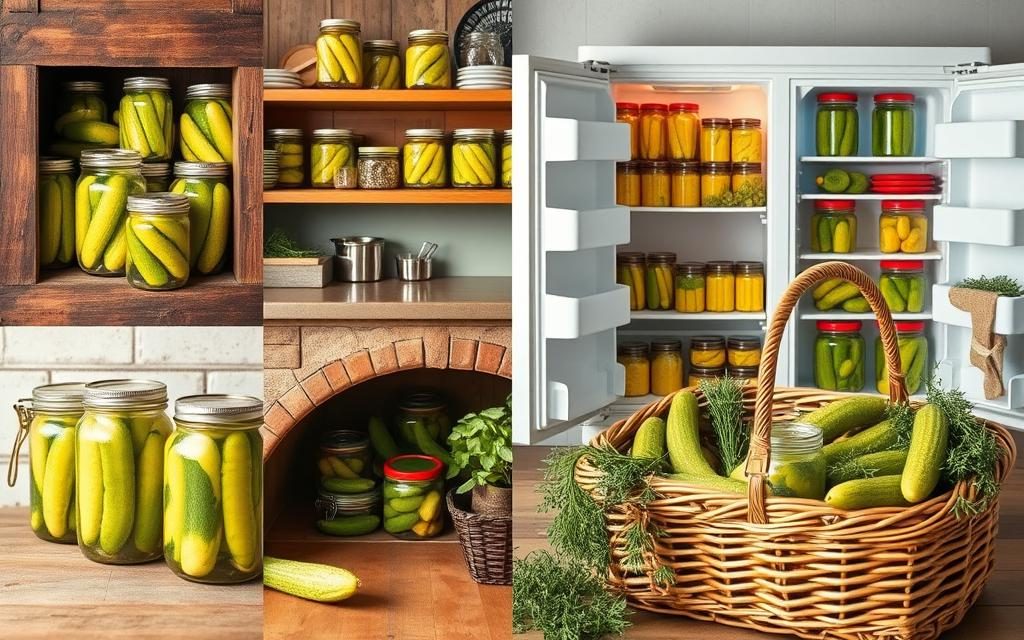
Ever wondered how to make pickling cucumbers into crunchy dill pickles? They can taste as good as store-bought ones. The secret is in mastering the pickling art and balancing ingredients.
Dill pickle recipes range from classic to spicy. They can make your taste buds dance. With simple ingredients and patience, you can make pickles that wow everyone.
This guide will show you 9 unique dill pickle recipes. You’ll learn how to turn cucumbers into crunchy, tasty treats. Whether you’re new or experienced, these recipes will improve your cooking.
Key Takeaways
- Learn multiple homemade dill pickle recipes
- Understand the pickling process from start to finish
- Discover techniques for achieving the perfect pickle crunch
- Explore both traditional and creative flavor variations
- Master safe canning and preservation methods
- Create delicious pickles with minimal kitchen experience
What Are Dill Pickles?
Dill pickles turn cucumbers into a tangy, crunchy treat. They have been loved for centuries. They show how food can be preserved and made tastier.
The history of dill pickles is quite interesting. It started with ancient people who used pickling to keep food fresh. Now, it’s a favorite flavor for many.
Origins of Dill Pickles
The story of dill pickles goes back to around 2030 BC in Mesopotamia. People from different places learned how to pickle cucumbers. Each group made their own special pickle types.
- Middle Eastern traders introduced pickling techniques
- European immigrants brought special recipes to America
- Jewish communities made kosher dill pickles in New York
Diverse Pickle Varieties
Pickles come in many flavors and ways of making them. Each type has its own taste:
| Pickle Type | Characteristics | Origin |
|---|---|---|
| Kosher Dill | Garlic-infused, tangy flavor | New York Jewish Delis |
| Polish Dill | Fermented, robust taste | Eastern European Tradition |
| German Dill | Crisp, herb-forward profile | Germanic Pickling Techniques |
Today, people love trying new pickle flavors. They celebrate a tradition that’s thousands of years old.
Essential Ingredients for Dill Pickles
Making tasty dill pickles needs the right ingredients. These turn simple cucumbers into crunchy, flavorful treats. The right mix makes your pickles stand out.
Choosing the Right Cucumbers
Not all cucumbers are good for pickling. Pickling cucumbers like Kirby or Boston are the best. They have thick skin and are small, making them perfect for pickling.
- Thicker skin for extra crunchiness
- Smaller size (4-6 inches long)
- Firm texture that holds up during pickling
The Role of Vinegar and Herbs
The brine is key to dill pickles. Distilled white vinegar (5% acidity) is the base. It works with kosher salt and fresh herbs to make a tangy taste.
| Ingredient | Purpose | Recommended Quantity |
|---|---|---|
| White Vinegar | Provides acidity | 1 quart per batch |
| Kosher Salt | Enhances flavor and preservation | 2/3 cup per 3 quarts water |
| Dill | Classic pickle flavoring | 1 dill head or 1 tsp dried dill seed per jar |
For pickling spices, try garlic, mustard seeds, and peppercorns. They add depth to your pickles. It’s all about finding the right mix for your taste.
Basic Dill Pickle Recipe for Beginners
Making homemade pickles is fun. It turns simple things into tasty treats. This easy recipe will help beginners make delicious dill pickles.
Before we start, let’s talk about what you need. The right ingredients and techniques are key to making great dill pickles at home.
Ingredients You’ll Need
- 10-12 fresh cucumbers (Kirby or pickling cucumbers preferred)
- 8-10 garlic cloves, smashed
- 10 fresh dill sprigs
- 1/4 cup kosher salt
- 1 tsp sugar
Brine Preparation
The brine is the secret to tasty pickles. Our recipe mixes vinegar, water, and spices for a perfect pickle.
| Ingredient | Quantity |
|---|---|
| White Vinegar | 3 cups |
| Water | 3 cups |
| Whole Black Peppercorns | 1 Tbsp |
| Coriander Seeds | 1 Tbsp |
| Red Pepper Flakes (optional) | 1 Tbsp |
Common Mistakes to Avoid
- Using old or soft cucumbers – Always choose fresh, crisp cucumbers
- Incorrect salt measurements – Use precise quantities
- Over-processing pickles – This can lead to mushy texture
Tip for dill pickling: Pick thin-skinned cucumbers like English, Kirby, or Persian. This recipe has a 4.7-star rating, showing it’s reliable for pickle lovers!
Refrigerator pickles last about 3-4 weeks. For longer storage, try canning. This involves boiling jars for 15 minutes.
Flavoring Your Dill Pickles: Herbs and Spices
Making the perfect dill pickle is like a fun art project. It’s all about mixing flavors to create something special. Dill pickle seasoning turns simple cucumbers into tasty treats that make your mouth happy.

Great pickling spices come from knowing how herbs and spices work together. Even though classic dill pickles are great, you can try new flavors too.
Classic Dill Flavor Foundation
A basic dill pickle recipe has:
- Fresh dill weed or dill seeds
- Whole garlic cloves
- Black peppercorns
- Mustard seeds
Creative Dill Ideas for Adventurous Picklers
If you want to make your pickles even better, try these:
- Spicy variations: Add jalapeños or red pepper flakes
- Aromatic blends: Use coriander seeds or bay leaves
- Sweet undertones: Add chopped onions
Remember, use fresh, good-quality spices for the best taste. Try different mixes to find your favorite dill pickle recipe.
Canning Dill Pickles: A Complete Guide
Pickle preservation is an art that needs care and precision. Canning dill pickles lets you enjoy homemade pickles all year. It captures summer’s fresh flavors in a jar. Knowing the right techniques can make your kitchen a pickle paradise.
Before you start canning dill pickles, you need the right tools. These tools help make sure your pickles are safe and tasty. Let’s look at the key tools and techniques for great pickle preservation.
Essential Canning Equipment
- Water bath canner
- Canning jars with new lids and rings
- Jar lifter
- Clean kitchen towels
- Large pot for preparing brine
Pickle Canning Safety Tips
Canning pickles needs careful attention to avoid foodborne illnesses. Follow these important safety tips:
- Sterilize all equipment well
- Use fresh, crisp cucumbers
- Keep the right vinegar-to-water ratio
- Process jars for the right time
| Canning Process Detail | Specification |
|---|---|
| Cucumber Size | 4-5 inches long, straight and skinny |
| Brine Composition | 4 cups water, 4 cups vinegar, 1/2 cup pickling salt |
| Processing Time | 10 minutes (below 1000 feet), 15 minutes (1000-6000 feet) |
| Storage Duration | Up to 1 year in cool, dark place |
Pro Tip: Wait at least 3 weeks after canning before enjoying your pickles. This lets flavors fully develop for the best taste.
Your homemade canned dill pickles can last up to a year if done right. The secret is keeping the right acidity and following tested canning methods. This ensures both safety and great flavor.
Quick and Easy Refrigerator Dill Pickles
Do you want a tasty and easy quick pickles recipe? Refrigerator dill pickles are great for making a tangy, crisp snack. They turn ordinary cucumbers into yummy treats in just a few steps.
Refrigerator pickles are easy to make. They don’t need complex canning steps. You get lots of flavor with just a little time.
Essential Ingredients for Refrigerator Dill Pickles
- 1½ pounds pickling cucumbers (Kirby or small bumpy varieties)
- 2-4 fresh garlic cloves
- Fresh dill sprigs
- Vinegar
- Water
- Salt
- Optional spices: peppercorns, jalapenos
Quick Prep Method
- Wash and slice cucumbers into desired shapes
- Prepare cool brine mixture
- Pack jars with cucumbers, garlic, and dill
- Pour cooled brine over cucumbers
- Seal and let sit at room temperature for 2-3 days
- Refrigerate and enjoy!
Pro tip: For extra crispiness, keep all ingredients cold before mixing. These pickles will stay crunchy and tasty for up to six weeks in the fridge.
Try different spices to make your pickles your own. You can have whole pickles, chips, or chunks. This recipe is very versatile.
Sweet vs. Sour Dill Pickles: Key Differences
Dill pickles come in two yummy types: sweet and sour. They have different tastes that can make any meal better.
The main difference is in their brine. Sweet pickles have more sugar for a mix of tangy and sweet. Sour pickles use a lot of vinegar for a sharp taste.
Understanding the Flavor Spectrum
Pickle fans can find out how sweet and sour differ. Here are some key points:
- Sweet dill pickles use 2 cups of sugar per quart of brine
- Sour dill pickles use almost no sugar
- Both have spices like dill and garlic
Crafting Your Perfect Pickle
Try making your own pickle brine to find your favorite taste. It’s all about finding the right mix of sugar and vinegar.
| Pickle Type | Sugar Content | Flavor Profile |
|---|---|---|
| Sweet Dill Pickles | High (2 cups per quart) | Balanced, mild sweetness |
| Sour Dill Pickles | Minimal to None | Sharp, tangy vinegar taste |
Choosing Your Pickle Style
Do you like sweet or sour pickles better? There’s a pickle out there for you. Remember, taste is personal, so try new things!
Fermented Dill Pickles: A Healthier Alternative
Exploring fermented pickles opens a world of nutrition. They are more than just pickles. They taste great and are good for your health.

Pickle fermentation is an old way to keep cucumbers fresh. It turns them into a health hero. Unlike vinegar pickles, fermented ones use natural bacteria for flavor and nutrition.
Benefits of Fermentation
- Boosts digestive health through beneficial probiotics
- Enhances nutrient bioavailability
- Supports immune system function
- Preserves original vegetable nutrients
- Creates a unique, complex flavor profile
Nutritional Comparison of Pickle Types
| Pickle Type | Probiotic Content | Preservation Method |
|---|---|---|
| Fermented Pickles | High | Saltwater Brine |
| Vinegar Pickles | Low | Vinegar Solution |
| Refrigerator Pickles | Minimal | Cold Storage |
Simple Fermented Dill Pickle Recipe
Making probiotic pickles at home is easy. You need fresh cucumbers, saltwater brine, dill, and garlic. Put everything in a jar, making sure cucumbers are covered. Let it sit for 3-7 days at room temperature.
Pro tip: Use specialized pickling cucumbers like National Pickling or Bush Pickle varieties for the best results in your fermented pickle adventure.
Creative Uses for Dill Pickles in Recipes
Dill pickles are more than just a snack. They can make simple dishes into something special. Try them in salads or as a sandwich spread for a burst of flavor.
Did you know about 23% of new recipes use dill pickles in salads? And 27% try them in exciting fried dishes. This shows how versatile pickles can be in cooking.
Dill Pickle Potato Salad: A Flavor Explosion
Make a tasty dill pickle potato salad. Mix boiled potatoes with chopped pickles. Here’s what you need:
- Boiled potatoes, cubed
- Finely chopped dill pickles
- Pickle brine for extra tang
- Creamy mayonnaise
- Fresh dill for garnish
Dill Pickle Relish: The Ultimate Sandwich Companion
Pickle relish makes any sandwich better. It’s great with many dishes:
| Dish Type | Pickle Relish Pairing |
|---|---|
| Sandwiches | Spread generously |
| Hot Dogs | Classic topping |
| Tuna Salad | Mixed for extra flavor |
| Chicken Salad | Adds crunch and zest |
Dill pickle recipes have different nutritional values. Calories range from 24 to 628 per serving. Fat content varies from 2g to 34g. This makes them good for many diets.
Also, 18% of pickle recipes include bacon, and 14% have cheese. These combinations show how pickles can fit into modern cooking.
How to Store Dill Pickles Properly
Storing pickles right is key for anyone who loves pickles. Knowing how to keep them fresh can make your homemade dill last for months. Check out this guide for tips.

Best Storage Practices for Pickle Preservation
Keeping pickles fresh needs the right storage. Here are some tips to keep your pickles tasty and crunchy:
- Store canned pickles in a cool, dark pantry
- Keep jars away from direct sunlight
- Maintain consistent temperature between 50-70°F
- Always use clean utensils when removing pickles
Pickle Shelf Life: Understanding Storage Duration
The time pickles last depends on how you store them:
| Pickle Type | Storage Location | Approximate Shelf Life |
|---|---|---|
| Properly Canned Pickles | Cool, dark pantry | Up to 1 year |
| Opened Canned Pickles | Refrigerator | 1-2 months |
| Refrigerator Pickles | Refrigerator | 2 months |
| Fermented Pickles | Refrigerator | 4-6 months |
Pro tip: Always check for signs of spoilage before eating stored pickles. Look for off-odors, mold, or texture changes.
Serving Suggestions for Dill Pickles
Dill pickles make any meal special. They add a tangy twist. Learning how to pair them can make you a better cook.
Perfect Pickle Pairings
Pickles go well with many foods. They add crunch and flavor. Here are some great pairings:
- Sandwiches and burgers
- Charcuterie boards
- Potato and tuna salads
- Grilled meats
Creative Pickle Appetizers
Make your pickles into fun appetizers. They will wow your guests and make their taste buds happy:
- Pickle Wraps: Cream cheese and deli meat wrapped around pickle spears
- Deep-fried pickle spears
- Pickle juice bloody marys
- Grilled pickle garnishes for cocktails
Serving Style Recommendations
| Occasion | Recommended Serving Style |
|---|---|
| Barbecue | Whole pickle spears |
| Cocktail Party | Sliced pickles on toothpicks |
| Lunch | Chopped in tartar sauce |
| Cheese Board | Pickle rounds as garnish |
Being creative with pickles is key. Try new ways to serve them. Find your favorite way to present pickles!
Troubleshooting Common Issues with Dill Pickles
Pickle lovers often face problems when making homemade dill pickles. Knowing these issues helps make crisp, tasty pickles. This guide will solve common problems and tips.
Why Your Pickles are Soft
Soft pickles can ruin your pickling plans. Use vinegar with at least 5% acidity. Make sure cucumbers stay covered in brine.
Trim 1/16th inch off the blossom end of cucumbers. This keeps them crunchy. Fresh, firm cucumbers are key for crunchy pickles.
Fixing Overly Sour Pickles
Too sour pickles often come from too much spice or overcooking. Use vinegar with 5% acidity for the right taste. If they’re too sour, add a bit of sugar.
Keep jars in a dark, cool, dry place. This keeps flavor and color good.
Getting better at pickling takes time. Watch water quality and keep fermentation at 70° to 75°F. Use fresh, quality ingredients for the best pickles.




